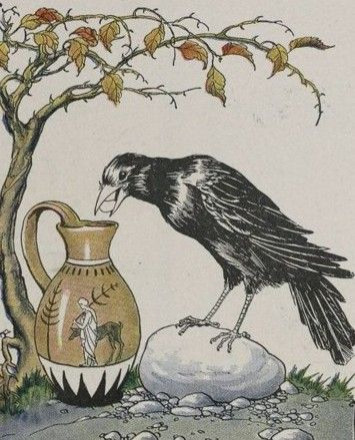Is A Crow Smarter Than A First Grader? New Caledonian Crows Have ‘Sophisticated’ Puzzle Solving Skills

Crows are the Einsteins and Da Vincis of the animal kingdom. Studies show that certain crows have an uncanny ability to remember human faces, use tools to complete some tasks and can even anticipate future events. And according to a new study of animal intelligence, at least one species of crow has the problem-solving abilities of a 5- to 7-year-old human.
Researchers from the University of Auckland in New Zealand conducted several experiments with New Caledonia crows, a tool-using species of crow endemic to the Pacific island near Australia. They wanted to see if the birds truly understand water displacement, a theory with roots in ancient lore.
In one of Aesop’s centuries-old fables called the “The Crow and the Pitcher,” a thirsty crow drops pebble after pebble into a jug containing a small amount of water to make the water level rise. To see whether real-life crows were true to their impressive reputation, researchers had six wild New Caledonia crows drop different objects into water-filled tubes to make a treat – in this case, a cube of meat – rise to within their reach.
Researchers arranged several different objects, some of which would sink and some of which would float, in front of the tubes. There were heavy rubber erasers and light polystyrene objects and also hollow and solid cubes. According to Live Science, the crows figured out that they could drop the heavy objects and the solid cubes into the tubes in order to reach their snacks.
In another experiment, researchers presented the birds with the task of dropping objects into tubes containing sand to see if they could comprehend that doing so wouldn’t make the treat rise in the tube.
According to Time, the crows quickly grasped the sand task and the principle of buoyant objects versus heavy objects. The birds demonstrated a tendency towards the solid objects, which displaced water, suggesting to researchers that the birds understood that not all objects are equal.
“Our results indicate that New Caledonian crows possess a sophisticated, but incomplete, understanding of the causal properties of displacement, rivalling that of 5- to 7-year-old children,” the researchers noted in their study, published in the journal PLOS One.
Researchers say the crows’ understanding is “incomplete” because the birds failed when it came to tests involving skinny tubes versus wide tubes. Dropping objects into skinny tubes quickly raised the water levels in the vessels, whereas dropping objects into wide tubes took much longer. Most of the birds went for wider tubes.
The results of the study could help scientists better understand the evolution of human intelligence.
"We can assess the factors which may have led to the evolution of different cognitive mechanisms, in particular the flexible problem solving, or intelligence, that we find in certain groups in the animal kingdom,” biologist Sarah Jelbert of the University of Auckland, who led the research, told the Sydney Morning Herald. "Understanding this could in turn help us to piece together the evolution of cognition in our own species."
This isn’t the first experiment to demonstrate a causal knowledge of using tools to serve an intended purpose in corvids, a family of birds that includes crows, jays, ravens and rooks. A 2009 study found that rooks figured out how to raise the level of water in a jar to gain a treat, and even learned that large stones were preferable to small stones.
"These studies have found that some corvids are not only superior in intelligence to birds of other avian species … but also rival many nonhuman primates,” researchers noted in 2009.
© Copyright IBTimes 2024. All rights reserved.






















